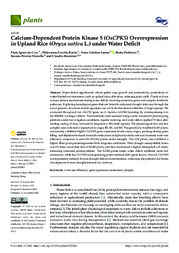Calcium-dependent protein kinase 5 (OsCPK5) overexpression in upland rice (Oryza sativa L.) under water deficit.
Calcium-dependent protein kinase 5 (OsCPK5) overexpression in upland rice (Oryza sativa L.) under water deficit.
Autoria: CRUZ, T. I. da; ROCHA, D. C.; LANNA, A. C.; DEDICOVA, B.; VIANELLO, R. P.; BRONDANI, C.
Resumo: Water deficit significantly affects global crop growth and productivity, particularly in water-limited environments, such as upland rice cultivation, reducing grain yield. Plants activate various defense mechanisms during water deficit, involving numerous genes and complex metabolic pathways. Exploring homologous genes that are linked to enhanced drought tolerance through the use of genomic data from model organisms can aid in the functional validation of target species. We evaluated the upland rice OsCPK5 gene, an A. thaliana AtCPK6 homolog, by overexpressing it in the BRSMG Curinga cultivar. Transformants were assessed using a semi-automated phenotyping platform under two irrigation conditions: regular watering, and water deficit applied 79 days after seeding, lasting 14 days, followed by irrigation at 80% field capacity. The physiological data and leaf samples were collected at reproductive stages R3, R6, and R8. The genetically modified (GM) plants consistently exhibited higher OsCPK5 gene expression levels across stages, peaking during grain filling, and displayed reduced stomatal conductance and photosynthetic rate and increased water-use efficiency compared to non-GM (NGM) plants under drought. The GM plants also exhibited a higher filled grain percentage under both irrigation conditions. Their drought susceptibility index was 0.9 times lower than that of NGM plants, and they maintained a higher chlorophyll a/b index, indicating sustained photosynthesis. The NGM plants under water deficit exhibited more leaf senescence, while the OsCPK5-overexpressing plants retained their green leaves. Overall, OsCPK5 overexpression induced diverse drought tolerance mechanisms, indicating the potential for future development of more drought-tolerant rice cultivars.
Ano de publicação: 2023
Tipo de publicação: Artigo de periódico
Unidade: Embrapa Arroz e Feijão
Palavras-chave: Arroz, Deficiência Hídrica, Drought, Gene expression, Oryza Sativa, Resistência a Seca, Rice, Senescence (aging), Water use efficiency
Observações
1 - Por padrão são exibidas publicações dos últimos 20 anos. Para encontrar publicações mais antigas, configure o filtro ano de publicação, colocando o ano a partir do qual você deseja encontrar publicações. O filtro está na coluna da esquerda na busca acima.
2 - Para ler algumas publicações da Embrapa (apenas as que estão em formato ePub), é necessário ter, no celular ou computador, um desses softwares gratuitos. Sistemas Android: Google Play Livros; IOS: iBooks; Windows e Linux: software Calibre.
Acesse outras publicações
Acesse a Base de Dados da Pesquisa Agropecuária (BDPA) para consultar o acervo completo das bibliotecas da Embrapa.

